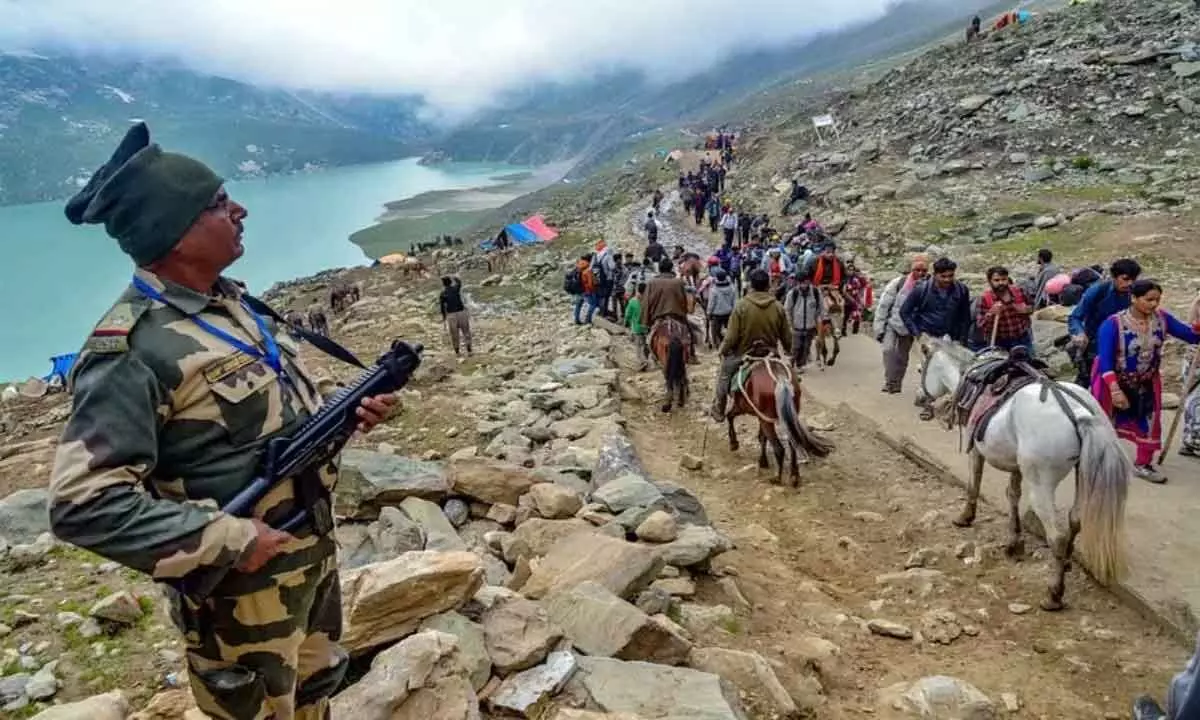Live
- Make all arrangements for smooth conduct of Group-2 exams
- CP congratulates chess champs
- Stage set for children’s science exhibition
- ‘Generation Green’ initiative to drive e-waste awareness
- Mysore royal family to get Rs 3,000 crore compensation for Palace Grounds
- Suspend officers who caned Panchamasali protesters: Bommai
- Unique move by student reaches over 1,500 in 8 countries
- Thudi takes up key issues with Uttam
- IRCTC to run ‘Maha Kumbh Punya Kshetra Yatra’
- BRS leader denies earthquake’s effect on Medigadda project
Just In
Security Measures For Amarnath Yatra Upgraded


- To bolster security measures for the annual Amarnath Yatra pilgrimage, the Indian Army has unveiled an upgraded three-tier security system.
- Brigadier Amandeep Mahli, representing the Indian Army, emphasized the crucial role of technology in the enhanced security framework, which encompasses quadcopters, night vision devices (NVDs), anti-drone teams, and bomb squads.
To bolster security measures for the annual Amarnath Yatra pilgrimage, the Indian Army has unveiled an upgraded three-tier security system. Brigadier Amandeep Mahli, representing the Indian Army, emphasized the crucial role of technology in the enhanced security framework, which encompasses quadcopters, night vision devices (NVDs), anti-drone teams, and bomb squads.
Brigadier Mahli underscored the implementation of multi-layered security arrangements, involving the Indian Army, Jammu & Kashmir Police, and Central Armed Police Force, along the entire Yatra route, including communication lines. He stated that regarding security, we have established multi-tiered security arrangements that encompass the Indian Army, Jammu & Kashmir Police, and Central Armed Police Force along the entire Yatra route, including the lines of communication.
In order to maintain constant monitoring, a comprehensive surveillance plan has been put into action, which involves the utilization of aerial surveillance assets and night vision devices. The incorporation of quadcopters and anti-drone teams showcases the adoption of advanced technology to address potential risks. The security framework has been carefully crafted to respect the desires of the local Kashmiri population, aiming to minimize disruptions for the residents in the area.
Taking lessons from past incidents, significant attention has been dedicated to Humanitarian Assistance Disaster Relief (HADR) plans. Brigadier Mahli remarked that in light of the cloud burst incident last year, we have given special emphasis to HADR plans. To ensure immediate medical assistance during emergencies, casualty evacuation helipads and medical detachments have been strategically placed along the entire route.
Moreover, the army has conducted comprehensive mock exercises on HADR and security, collaborating with stakeholders like the National Disaster Management Authority. This proactive approach showcases their readiness to effectively handle any unforeseen circumstances.
To address potential risks in avalanche-prone areas, specialized avalanche, and mountain rescue teams have been deployed at critical locations, keeping them under constant surveillance. Additionally, resources have been allocated to enhance the facilities for yatris at Panchtarni and Nunwan, aiming to improve their living conditions.
Brigadier Mahli emphasized the army's dedication to synchronized preparations for the yatra through collaborative efforts with various stakeholders, including the Shri Amarnath Ji Shrine Board, Civil Administration, Jammu & Kashmir Police, and Central Armed Police Force. He also recognized the significant role played by the Border Roads Organization in clearing the Southern route, which faced snow levels of 12 to 14 feet at certain locations.
Meanwhile, as the 62-day Shri Amarnath Ji Yatra commenced, Brigadier Mahli extended a heartfelt welcome to all pilgrims and assured them of the utmost security throughout their pilgrimage journey.

© 2024 Hyderabad Media House Limited/The Hans India. All rights reserved. Powered by hocalwire.com






